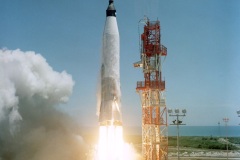Mercury-Atlas 3 (MA-3) was an unmanned test flight as part of the Mercury program.
The Atlas (Missile 100-D) used for the flight featured a number of technical improvements, including a thicker hull to handle the additional weight of the Mercury capsule and prevent a recurrence of the Mercury-Atlas 1 failure. In addition, it featured a new transistor telemetry unit, replacing the old-fashioned system found on previous Atlas vehicles, which used vacuum tubes, was bulky, had high power consumption, and had a tendency to decrease signal strength upon startup. The revised telemetry box was originally developed for the Atlas-Centaur and was quickly adapted to the Mercury program.
Although the flight was unmanned, all systems functioned as if there were an astronaut on board.
The flight proceeded normally until 40 seconds after launch when the rocket went off course. Due to a software error, the rocket did not tilt to the east, but continued to fly vertically upwards. An engine failure would have been a danger to the surrounding areas as well as to Cape Canaveral itself. So it was decided to blow up the rocket, but they wanted to save the capsule using the escape tower.
The rescue tower worked perfectly and brought the Mercury capsule to safety. The capsule reached an apogee of 7.2 km and traveled only 1.8 km. The Mercury capsule’s flight lasted 7 minutes and 19 seconds, most of the time spent descending on the parachute. The Mercury capsule landed safely and was recovered in the Atlantic about 20 minutes after launch and reused on the next flight (MA-4) as Mercury spacecraft #8A. Hardly a piece of the launch vehicle was found.
A reassuring fact for the Mercury team was that the flight confirmed the reliability of the launch escape system. This was also the only use of the rescue tower as part of the Mercury program.
Mission data |
|
|---|---|
Mission |
Mercury-Atlas 3 (MA-3) |
Rocket |
Atlas 100-D |
Spacecraft |
Mercury capsule #8 |
Launch date |
April 25, 1961 |
Launch site |
Launch Complex 14 (LC-14), Cape Canaveral, Florida |
Mission duration |
7 min 19 sec |
Altitude |
7.2 km |
Distance |
1.8 km |
Velocity |
1,894 km/h |
Max G |
11 g |


